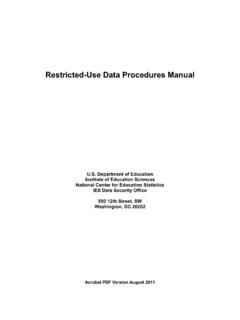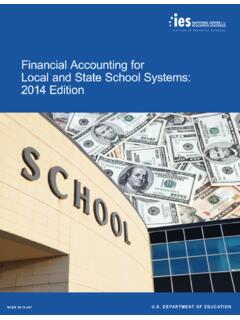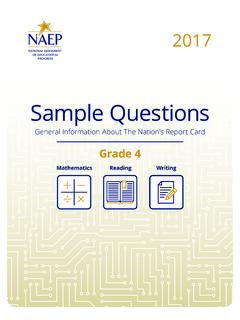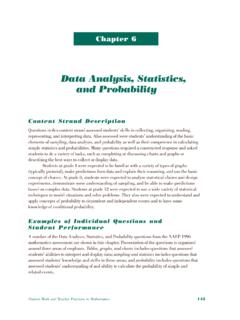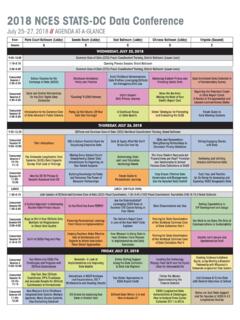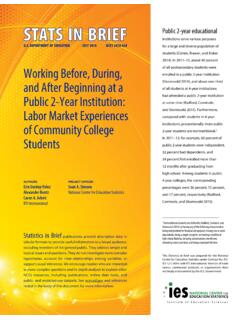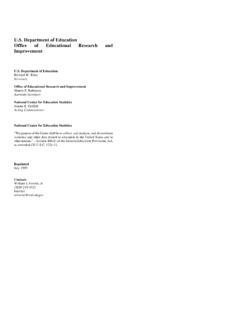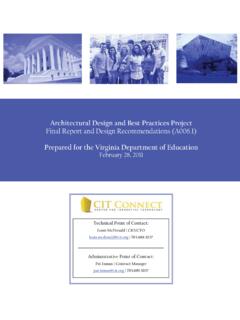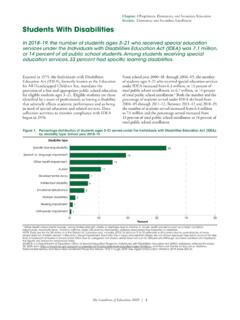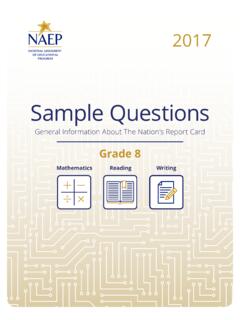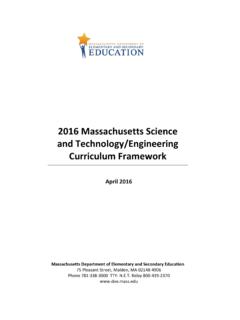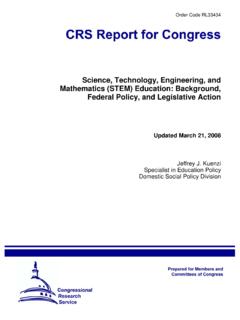Transcription of STATS IN IE As technical and scientific
1 STATS IN DEPARTMENT OF EDUCATION FEBRUARY 2015 NCES 2015 075 Gender Differences in Science, technology , engineering , and Mathematics (STEM) Interest, Credits Earned, and NAEP Performance in the 12th Grade AUTHORSB rittany C. Cunningham American Institutes for ResearchKathleen Mulvaney Hoyer Dinah SparksActivate Research, OFFICERJohn Ralph National Center for Education StatisticsStatistics in Brief publications present descriptive data in tabularformats to provide useful information to a broad audience, including members of the general public. They address topical issues and questions. They do not investigate more complex hypotheses, account for inter-relationships among variables, or support causal inferences. We encourage readers who are interested in more complex questions and in-depth analysis to explore other NCES resources, including publications, online data tools, and public- and restricted-use datasets.
2 See and references noted in the body of this document for more publication was prepared for NCES under Contract No. ED-IES-12-D-0002 with American Institutes for Research. Mention of trade names, commercial products, or organizations does not imply endorsement by the technical and scientific innovation continue to drive the global economy, educators, policymakers, and scientists seek to promote students interest and achievement in the STEM fields to maintain the nation s competitive position (National Academy of sciences 2006; National Science Board 2007; President s Council of Advisors on Science and technology 2012). Many researchers have studied differences in male and female students attitudes toward and performance in STEM courses and assessments. While some research shows that gaps in male and female performance on STEM-related assessments have narrowed or even closed (Lindberg et al. 2010), other research continues to report gender differences in student affective dispositions ( , interest) toward mathematics and science, as well as differences in student performance in mathematics and science, especially in math-intensive science fields (Ceci et al.)
3 2014; White House Council on Women and Girls 2011). This Statistics in Brief describes high school graduates attitudes toward STEM courses (specifically, mathematics and science), credits earned in STEM fields, and performance on the National Assessment of Educational Progress (NAEP)mathematics and science assessments in 2009. 2 High School STEM CoursesSTEM fields1 include mathematics; the natural sciences , including the physical sciences and biological/agricultural sciences ; engineering / engineering technologies; and computer/information sciences . The STEM courses examined in this brief fall into three broad categories:1. Advanced mathematics: Includes algebra II, other advanced mathematics courses, precalculus/analysis, and calculus. The other advanced mathematics courses are trigonometry, statistics/probability, algebra III, analytic geometry, International Baccalaureate (IB) mathematics, and discrete Advanced science and engineering : engineering courses include academic courses in which students apply mathematics and science skills and concepts to engineering problems as well as a few specialized courses ( , survey/mapping sciences and metallurgy).
4 Advanced science courses include advanced biology, chemistry, physics, and advanced environmental/earth sciences . Advanced biology courses include Advanced Placement (AP)/1 The classification of the STEM categories and the associated courses is consistent with previously published analyses of the NAEP HSTS (Laird, Alt, and Wu 2009; Nord et al. 2011).IB biology, physiology, anatomy, and genetics. Advanced environmental/earth sciences courses include AP/IB environmental science, college preparatory earth science, and various geology courses. 3. STEM-related technical : Includes computer/information science, engineering /science technologies, and health science/technologies. engineering / science technology courses refer to courses that focus on technical tasks used in engineering and science occupations, such as instrumentation or equipment maintenance. Computer/information science includes computer programming, logic, algorithms, and systems administration but does not include courses that instruct students in using software ( , processing).
5 Health science/technologies include an array of courses associated with occupations in the allied health fields. Throughout the brief, reported findings related to specific STEM courses are grouped into these three SOURCES AND ANALYTIC SAMPLEThis brief uses data from two sources to investigate the research questions. The first is the 2009 NAEP High School Transcript Study (HSTS), conducted in conjunction with the 2009 NAEP assessment administration. The HSTS is designed to collect information about high school graduates coursetaking patterns, credits earned, GPA, NAEP mathematics and science performance, and student information such as gender, race/ethnicity, and parent education level. The HSTS also collects information on the schools that these graduates attended. Exploration of the HSTS data allows for a deeper examination of STEM fields at the coursetaking level. Consistent with previously published analyses of the HSTS (Laird, Alt, and Wu 2009; Nord et al.)
6 2011), the current analysis limits the analytic sample to high school graduates who earned regular or honors diplomas and excludes those who received a special education diploma, certificate of completion (or attendance), and students who did not graduate or had less than 3 years of transcript Data for this brief also come from the 2009 NAEP Grade 12 Mathematics and Science Student Questionnaires, which collected information from students on their classroom experiences and educational support. The questionnaire items used in this brief asked students about their interest in mathematics and science, which is measured by students rating of the extent to which they agreed or disagreed with the following statements: 2 The HSTS is restricted to high school graduates and contains no information about dropouts, who may differ in certain characteristics from graduates. I like mathematics, Mathematics is one of my favorite subjects, I like science, and Science is one of my favorite subjects.
7 The estimates reported in the brief combine the agree and strongly agree response categories to produce an indicator of high school graduates who have an interest in mathematics or science. The findings reported constitute an illustrative rather than exhaustive list of significant results of the study. Comparisons highlighted in the text are statistically significant at the p < .05 level to ensure that differences are larger than might be expected due to sampling variation; no adjustments were made for multiple comparisons. For further details on the analytic sample, NAEP questionnaires, or study methods, see technical Notes toward the end of this QUESTIONS1 Among 2009 high school graduates, how does interest in mathematics and science differ by gender?2 Among 2009 high school graduates, how does earning credit in STEM courses differ by gender? 3 Among 2009 high school graduates, how do the NAEP mathematics and science scale scores of students who earned credits in STEM courses differ by gender?
8 KEY FINDINGS In 2009, compared to males, lowerpercentages of female high schoolgraduates reported that they likedmathematics or science and thatmathematics or science was oneof their favorite subjects (figure 1,page 4). Compared to males, higherpercentages of female 2009 highschool graduates took algebra II,precalculus, advanced biology,chemistry, and health science/ technology courses (table 1, page 7). Generally, among 2009 high schoolgraduates who had earned creditsin specific mathematics and sciencecourses, males had higher averageNAEP mathematics and NAEP science scale scores than females(figures 4 6, pages 8 10).FIGURE of high school graduates who reported interest in mathematics and science, by gender: 2009 MaleFemale5953*5043*7059*4834*Science is oneof my favoritesubjectsLike sciencePercentMathematics isone of myfavorite subjectsLikemathematics020406080100* Significantly different from males at the p < .05 : Respondents were asked to indicate how much they disagree or agree with the following statements: I like math-ematics/science and Mathematics/science is one of my favorite subjects.
9 Respondents could answer: Strongly disagree, Disagree, Agree, or Strongly agree. The responses Agree and Strongly agree have been combined for estimates of like mathematics/science and mathematics/science is one of my favorite subjects. SOURCE: Department of Education, Institute of Education sciences , National Center for Education Statistics, High School Transcript Study (HSTS), 2009; National Assessment of Educational Progress (NAEP), 2009 Mathematics and Science 2009 high school graduates, how does interest in mathematics and science differ by gender?In general, a higher percentage of male than female high school graduates expressed interest in mathematics, and the same was true for interest in science. As shown in figure 1 (page 4), in 2009, a higher percentage of males than females reported that they liked mathematics (59 vs. 53 percent). In addition, 50 percent of male high school graduates said that mathematics was one of their favorite subjects, compared to 43 percent of female high school graduates.
10 Similarly, in 2009, higher percentages of males reported that they liked science or that science was a favorite general pattern of higher percentages of males than females reporting interest in mathematics and science is evident among some additional subgroups of high school graduates. For example, in 2009, 3 The questionnaire items used to gather data on respondents mathematics and science interest do not measure interest in specific mathematics or science subjects or sub-disciplines. However, other research has shown that gender differences in STEM engagement are not uniform across mathematics and science subject topic areas (Ceci et al. 2014). Sub-discipline-specific gender differences should be considered when interpreting gender differences in the broader categories of mathematics and science presented in this racial/ethnic groups, higher percentages of male graduates reported that they liked mathematics or science and that mathematics or science was a favorite subject, compared to female graduates (figures 2 and 3, page 6).
